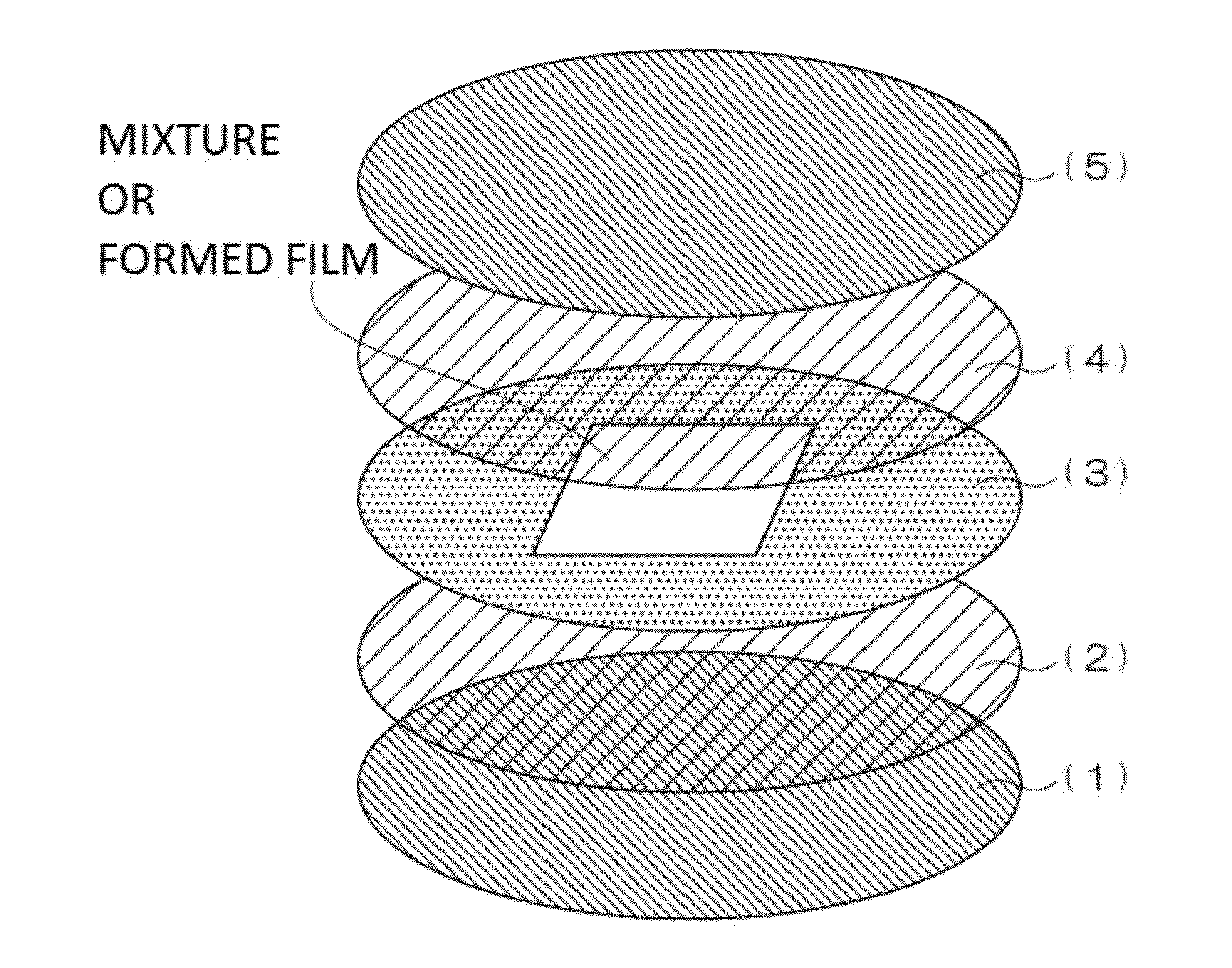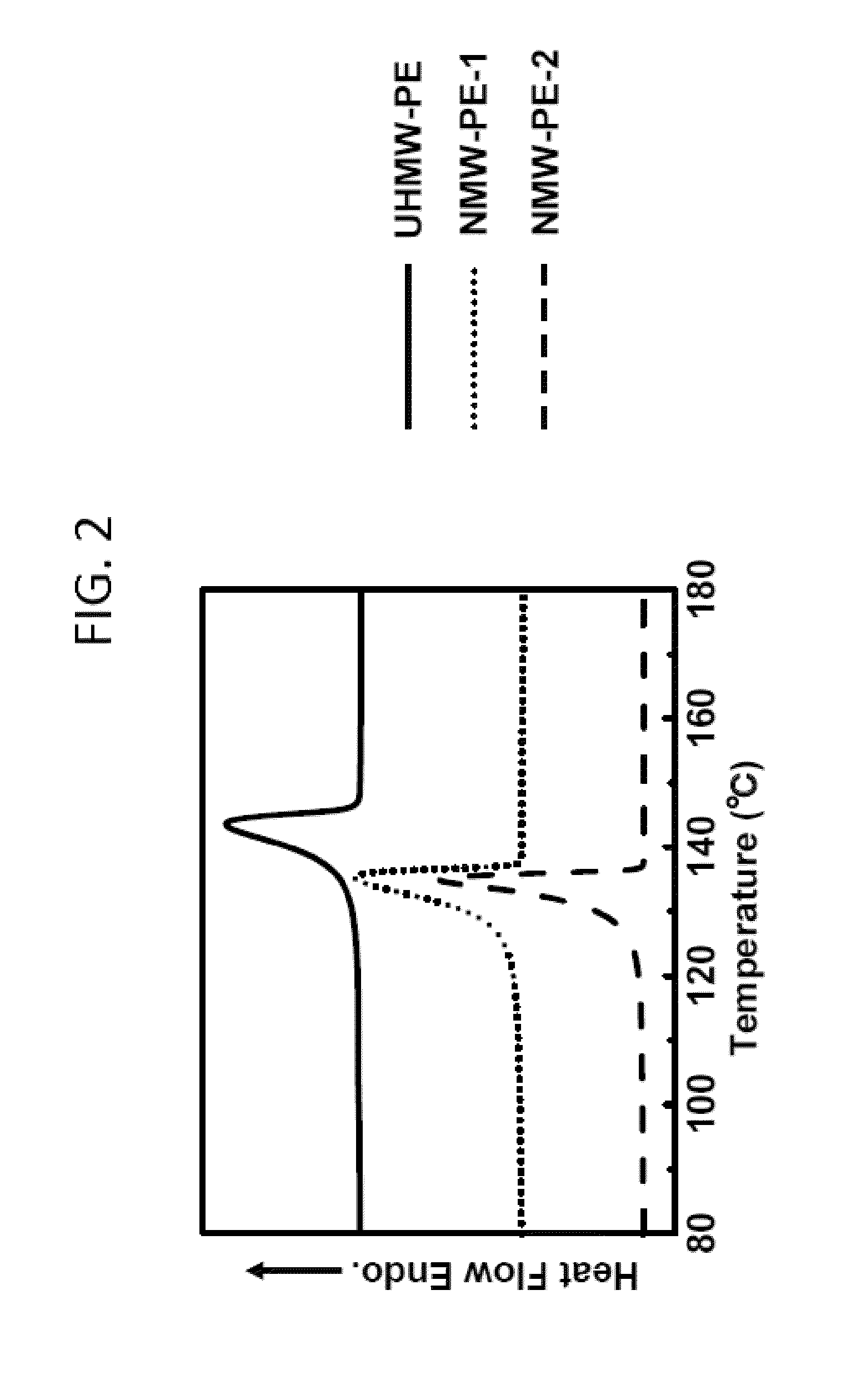Process for Producing Polyethylene Porous Film and Polyethylene Porous Film
a technology of polyethylene porous film and polyethylene porous film, which is applied in the direction of cell components, cell components, membranes, etc., can solve the problems of short circuit of batteries, polyethylene porous film in which the pores are formed, and environmental load with volatilization of organic solvent becomes problematic, etc., to achieve high gas permeation coefficient, large pore volume, and specific surface area
- Summary
- Abstract
- Description
- Claims
- Application Information
AI Technical Summary
Benefits of technology
Problems solved by technology
Method used
Image
Examples
example 1
(a) Mixture Preparation Process
[0196]Powdered UHMW-PE (Hizex Million 340M produced by Mitsui Chemicals, Inc., My=3.5×106, average particle diameter: 150 μm), powdered NMW-PE-1 (J-REX KX285N produced by Japan Polyolefins Corporation, Mw=1.1×105, average particle diameter: 300 μm), and powdered NMW-PE-2 (Mw=1.4×105, average particle diameter: 250 μm) are provided.
[0197]The following table 1 shows details of those polyethylene raw materials. The polyethylene raw materials are those synthesized using Ziegler-based catalysts.
TABLE 1ViscosityWeightNumberMolecularaverageaverageaverageweightMeltingmolecularmolecularmoleculardistri-pointweight Mvweight Mwweight MnbutionTm(g / mol)(g / mol)(g / mol)Mw / Mn(° C.)UHMW-PE3.5 × 1061.8 × 1062.3 × 1057.8140.1NMW-PE-1—1.1 × 1051.7 × 1046.0136.3NMW-PE-2—1.4 × 1052.1 × 1046.5135.0
[0198]The melting point (Tm) of each of those polyethylene raw materials is the endothermic peak temperature (° C.) estimated from a DSC melting profile shown in FIG. 2.
[0199]With re...
example 2
[0238]In Example 2, a polyethylene porous film was obtained similarly to Example 1, except that the mixing ratio of UHMW-PE and NMW-PE-1 was changed to 50:50.
[0239]When the oxygen permeation coefficient and the mechanical strength of a heat-treated film before the pore formation treatment were measured similarly to Example 1, the oxygen permeation coefficient was 2.33×10−15 mol·m / (m2·s·Pa), and the tensile breaking strength was 20.5 MPa.
[0240]The obtained polyethylene porous film of Example 2 was evaluated similarly to Example 1. As a result, the average pore diameter was 90.9 nm, the specific surface area was 100.3 m2 / g, and the porosity was 34.2%.
[0241]Meanwhile, the oxygen permeation coefficient was 9.04×10−11 mol·m / (m2·s·Pa), and it was found that the polyethylene porous film of Example 2 exhibits an excellent pore communication property.
[0242]Further, the tensile breaking strength of the polyethylene porous film of Example 2 was 29.7 MPa, and it was found that the polyethylene ...
example 3
[0244]In Example 3, a polyethylene porous film was obtained similarly to Example 1, except that the mixing ratio of UHMW-PE and NMW-PE-1 as raw materials was changed to 60:40.
[0245]The obtained polyethylene porous film of Example 3 was evaluated similarly to Example 1. As a result, in the polyethylene porous film of Example 3, the average pore diameter was 89.0 nm, the specific surface area was 239.9 m2 / g, and the porosity was 53.8%.
[0246]The oxygen permeation coefficient was 8.27×10−12 mol·m / (m2·s·Pa), and it was found that the polyethylene porous film of Example 3 exhibits an excellent pore communication property.
[0247]Further, the tensile breaking strength of the polyethylene porous film of Example 3 was 29.8 MPa, and it was found that the polyethylene porous film of Example 3 has excellent mechanical properties.
PUM
| Property | Measurement | Unit |
|---|---|---|
| temperature | aaaaa | aaaaa |
| porosity | aaaaa | aaaaa |
| specific surface area | aaaaa | aaaaa |
Abstract
Description
Claims
Application Information
 Login to View More
Login to View More - R&D
- Intellectual Property
- Life Sciences
- Materials
- Tech Scout
- Unparalleled Data Quality
- Higher Quality Content
- 60% Fewer Hallucinations
Browse by: Latest US Patents, China's latest patents, Technical Efficacy Thesaurus, Application Domain, Technology Topic, Popular Technical Reports.
© 2025 PatSnap. All rights reserved.Legal|Privacy policy|Modern Slavery Act Transparency Statement|Sitemap|About US| Contact US: help@patsnap.com



